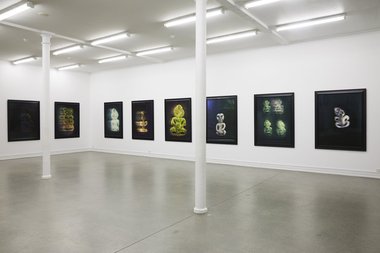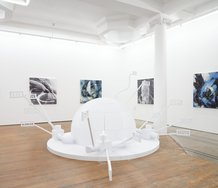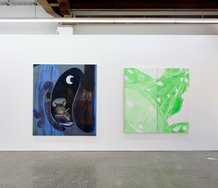John Hurrell – 26 June, 2019
In her treatment of these green, brown, cream and butterscotch images, Pardington positions each carving against a backdrop of unfurled corregated ribbon (several sections joined together), with a horizontal speckled texture that catches the light with an occasional flare, sparkle and shimmer. Her ‘faux hei-tiki' are often blurred, or filled with light like glass vessels, or made so that the surface veiny texture inhabits within—like a fly in resin.
These new hei-tiki photographs that Fiona Pardington has photographed in London rub our noses in issues of cultural legitimacy and the nature of the genuine—and possibly the spiritual. Carved by European whalers or sealers, or much later (towards the end of the nineteenth century) by mimicking Europeans in the northern hemisphere, or perhaps Māori without the prestige or knowledge to do so—and now part of the Wellcome Collection (highly regarded as a curator’s cornucopia)—their ‘documentary’ treatment by the artist impress formally through scale and glowing, and occasionally reflected, colour.
Theatrical in their manipulation of light, so that it now radiates from within, and not merely reflecting the surface, these images (available in three sizes) of inauthentic hei-tiki carved in jade or bone—it could be argued—upstage Pardington’s earlier photographs of genuine taonga. Her ‘special effects’ take your breath away. If you were to take home a gut-level message from looking at them, it would be that these objects surely are spiritual.
Some of them however, are obviously morphologically dubious. Their intricate circular motifs look Celtic for example, or they have a strange squashed flatness in their torso, or include bizarre elements such as ‘unMāori’ vesica-piscus ‘vaginal’ shapes on their bellies—as if transported from the skies behind some early Renaissance paintings of saints.
In her treatment of these green, brown, cream and butterscotch images, Pardington positions each carving against a backdrop of unfurled corrugated ribbon (several sections joined together), with a horizontal speckled texture that catches the light with an occasional flare, sparkle and shimmer. Her ‘faux hei-tiki’ are often blurred, or filled with light like glass vessels, or made so that the surface veiny texture inhabits within—like a fly in resin. The hovering evanescent forms flicker and pulse, especially those that are variations arranged in a grid.
The odd thing is how in comparison Pardington’s authentic hei-tiki photographs have now become more understood for their subtlety. Looking relatively subdued, maybe they attain greater dignity. They don’t scream out for attention; they have a confidence in their own self worth. Their value is understood. Quiet, sedate and appreciated.
Having said that, I prefer the fakes and what Pardington has done with them. I like their ostentation—what some might call their over-the-top vulgarity—their refusal to be meek. I’m a hardcore atheist who tends to scoff at any claims of the spiritual, but their bleary light (Pardington’s skilled manipulation) enraptures me every time.
John Hurrell
Recent Comments
Ralph Paine
WHEN All things began, the Copy already was. The Copy dwelt with God, and what God was, the Copy was.

















 Advertising in this column
Advertising in this column Two Rooms presents a program of residencies and projects
Two Rooms presents a program of residencies and projects



This Discussion has 1 comment.
Comment
Ralph Paine, 1:22 p.m. 27 June, 2019 #
WHEN All things began, the Copy already was. The Copy dwelt with God, and what God was, the Copy was.
Participate
Register to Participate.
Sign in
Sign in to an existing account.